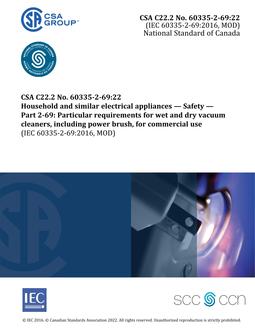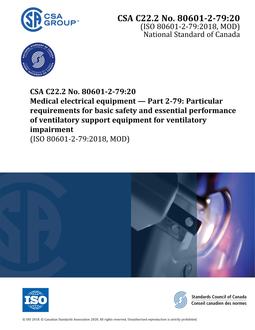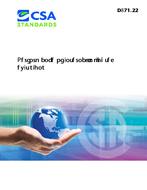Click here to purchase
Preface:
This is the fourth edition of CSA C22.2 No. 250.13, Light emitting diode (LED) equipment for use in lighting applications, one of a series of standards issued by CSA Group under Part II of the Canadian Electrical Code. It supersedes the previous editions published in 2017, 2014, and 2012.
This Standard is based on, and includes copyrighted text from, UL 8750, Light Emitting Diode (LED) Equipment for Use in Lighting Products. UL 8750 is reprinted with permission from Underwriters Laboratories Inc. (UL), which owns the copyrights in UL 8750. UL shall not be responsible for the use or reliance upon a UL standard by anyone. UL shall not incur any obligation or liability for damages, including consequential damages, arising out of or in connection with the use, interpretation of, or reliance upon a UL standard. Revisions of UL standards are issued from time to time. A UL standard is current only if it incorporates the most recently adopted revisions.
For general information on the standards of the Canadian Electrical Code, Part II, see the Preface of CAN/CSA-C22.2 No. 0, General Requirements — Canadian Electrical Code, Part II.
This Standard has been developed in compliance with Standards Council of Canada requirements for National Standards of Canada. It has been published as a National Standard of Canada by CSA Group.
Scope:
1.1
1.1.1
The requirements specified in this Standard cover light-emitting diode (LED) equipment that is an integral part of a luminaire or other lighting equipment and that operates in the visible light spectrum between 400 and 700 nm. These requirements also cover the component parts of LED equipment, including LED controlgear, controllers, arrays, modules, and packages, as defined in this Standard.
1.1.2
LED controllers covered in this Standard are intended to be
a) integral to the luminaire; or
b) located remotely from the luminaire when the LED controller is supplied from and controls the luminaire using only Class 2 circuits.
1.1.3
These requirements do not cover the following LED controllers:
a) intended for installation inside a remote electrical outlet box containing Class 1 circuits;
b) light- or presence-sensitive plug-in locking?type photo controls for use with area lighting covered by CSA C22.2 No. 284; or
c) solid-state dimming controls covered by CSA C22.2 No. 184.1.
1.2
These lighting products are intended for installation on branch circuits of 600 V nominal or less, in accordance with CSA C22.1, Canadian Electrical Code, Part I, and for connection to isolated (non–utility connected) power sources, such as generators, batteries, fuel cells, solar cells, and the like.
1.3
1.3.1
LED equipment is utilized in lighting products that comply with the end- product standards listed in this Clause. The requirements specified in this Standard are intended to supplement those in other end-product standards.
1.3.2
LED luminaires comply with the following end-product standards:
a) CSA C22.2 No. 207;
b) CSA C22.2 No. 12;
c) CSA C22.2 No. 89;
d) CSA C22.2 No. 141;
e) CSA C22.2 No. 166;
f) CSA C22.2 No. 9.0;
g) CSA C22.2 No. 250.0;
h) CSA C22.2 No. 256;
i) CSA C22.2 No. 250.7;
j) CSA C22.2 No. 1993;
k) CSA TIL B-31B; and
l) CSA TIL B-39.
Note: Where end applications are not covered by this Standard and no applicable end-product standards exist, additional end-product evaluations using applicable standards are needed. Such end applications include, but are not limited to, LED equipment installed in air handling spaces or in other environmental air spaces (plenums), LED equipment in recessed installations where direct contact with thermal insulation could occur, and LED equipment used in fire-rated installations.
1.3.3
LED control gear complies with the following end-product standards:
a) CAN/CSA-C22.2 No. 223; and
b) CAN/CSA-C22.2 No. 60950-1.
1.3.4
Requirements for temperature-limited LED control gear are specified in Annex G.
1.4
In this Standard, “shall” is used to express a requirement, i.e., a provision that the user is obliged to satisfy in order to comply with the Standard; “should” is used to express a recommendation or that which is advised but not required; and “may” is used to express an option or that which is permissible within the limits of the Standard. Notes accompanying clauses do not include requirements or alternative requirements; the purpose of a note accompanying a clause is to separate from the text explanatory or informative material. Notes to tables and figures are considered part of the table or figure and may be written as requirements. Annexes are designated normative (mandatory) or informative (non-mandatory) to define their application.
1.5
The values given in SI units are the units of record for the purposes of this Standard. When used, the values given in parentheses are for information and comparison only.
Product Details
- Edition:
- 4th
- Published:
- 04/01/2020
- ISBN(s):
- 9781488329029
- Number of Pages:
- 144
- File Size:
- 1 file , 1.5 MB
- Product Code(s):
- 2428064, 2428064


